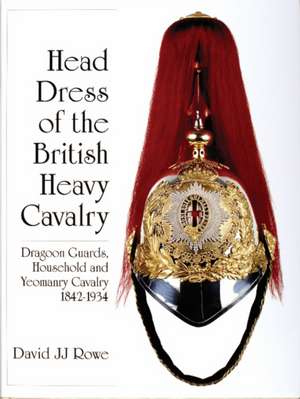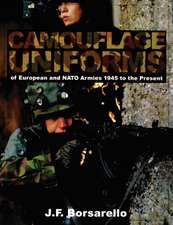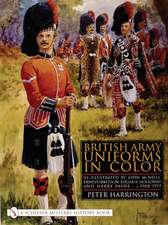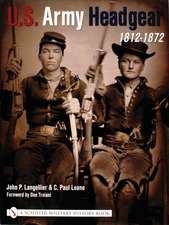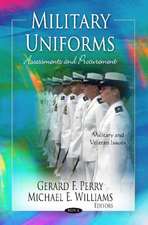Head Dress of the British Heavy Cavalry: Dragoon Guards, Household, and Yeomanry Cavalry 1842-1922
Autor David JJ Roween Limba Engleză Hardback – 14 dec 1999
Preț: 405.78 lei
Preț vechi: 511.01 lei
-21% Nou
Puncte Express: 609
Preț estimativ în valută:
77.65€ • 81.44$ • 64.64£
77.65€ • 81.44$ • 64.64£
Carte disponibilă
Livrare economică 11-25 martie
Preluare comenzi: 021 569.72.76
Specificații
ISBN-13: 9780764309571
ISBN-10: 0764309579
Pagini: 256
Ilustrații: 135 color and b/w photos
Dimensiuni: 228 x 304 x 25 mm
Greutate: 1.91 kg
Editura: Schiffer Publishing Ltd
Colecția Schiffer Military
ISBN-10: 0764309579
Pagini: 256
Ilustrații: 135 color and b/w photos
Dimensiuni: 228 x 304 x 25 mm
Greutate: 1.91 kg
Editura: Schiffer Publishing Ltd
Colecția Schiffer Military
Notă biografică
David Rowe was born in the East End of London, the son of a former fireman, he lived until his late teens close to the Bloomsbury area of Central London, and was educated at Hugh Middleton Central School, Clerkenwell, built on the site of a former seventeenth century prison. He spent two years in the civil service, before joining an american plastics company as their Machine Accounts Editor, and spent over two years as a part-time firefighter with the London Fire Brigade, where he saw service at a busy fire station in Clerkenwell, and was present at what was at the time, the worst fire in London since the blitz of the Second World War. Upon leaving the plastics company he entered local Government by joining the City of Westminster, and whilst there, having started at the bottom rung of the ladder was soon promoted to a junior officer position. Upon completing his studies at Technical College, he received a further promotion at Westminster, and later went on to serve with Kensington and Chelsea in the west of London, and at Hackney in the east of the City, before leaving the capital to take up a Principal Officer post in Hampshire. He is a member of both the Institute of Wastes Management (Rtd), and the Institute of Municipal Transport (Rtd). Having decided upon a change of career, he joined the Ministry of Defence, being attached to a squadron of the Royal Corps of Signals at Aldershot Militaria Society. Having taken early retirement and upon becoming semi-retired, he decided to utilise his spare time by once again putting his knowledge of military head-dress onto paper - he having previously written articles on this subject for both Military Modeling Magazine, and the Journal of the Crown Imperial Society his book Head Dress of the British Heavy Cavalry being published in late 1999. He has one son and four daughters, and now divorced, lives in a small village some ten miles from the old military garrison town of Colchester, Essex William Carman was born in Ottawa, Canada, the son of a professional soldier, he moved to England and lived at Mortlake, attending school at Barnes, Surrey. After serving some five years in the British Army, and upon his discharge, he turned his hand to producing finely detailed scale model soldiers which were sold through various quality outlets. In 1950 he joined the staff of the Imperial War Museum at Lambeth, later transferring to the National Army Museum at Chelsea, where he served continuously until taking retirement whilst holding the post of Deputy Director of the Museum. Having been retired some good few years, he has continued with his love of matters military and has been a major contributor to various established militaria societies, as well as writing articles for such well known periodicals as Military Illustrated, and Military Modelling, in addition to the Men-at-Arms series of booklets. Hie is a Fellow of the Organisation of Military Museums of Canada, the Royal Historical Society, the Society of Antiquaries, and the Company of Military Historians, and is a past President of the British Model Soldier Society, the Military Heraldry Society, and the Society for Army Historical Research. He has a son and a daughter, and now a widower lives in Sutton, Surrey.
